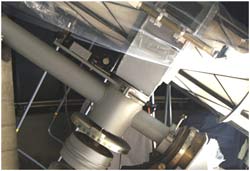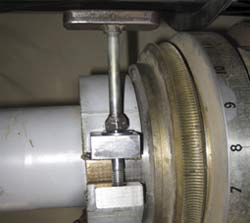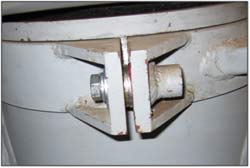Telescope Clamps
Background
| The telescope uses an equatorial mount with two axis that require clamps to set the position of telescope. The previous clamps did not apply adequate force and did not securely lock the telescope into place; it could be bumped out of position easily. The lower clamp acts as a clutch that locks in the drive motor to compensate for the earth’s rotation. The second clamp locks in the declination, or north and south adjustment. |
 |
Research
The clutch clamp is composed of an open ended steel ring with a fibrous backing that makes direct contact with the telescope mount. On the ends of the ring there are two tabs with two steel stabilizing blocks that lock and tighten via a steel rod. The steel rod has a welded bolt that pulls the steel ring together locking the telescope in place.
Design / Prototyping
| The upper clamp was limited to modifying the handle arrangement or changing the handle type. This restriction was due to the fact that the body of the clamp also acts as a support for the fine adjustment components.
Cam levers would have been a user friendly, inexpensive option that would apply adequate force to the clamp body. Due to the restrictions of the existing system, there were no cam levers “off the shelf” that had a long enough fine threaded stud to engage the clamp. This option was not selected . |
 |
Final Solution
| The best solution for the lower clamp was to fabricate a larger metal block which could apply clamping force without bending. |
 |
| The upper clamp was fixed by inserting shims into one side of the clamp, which reduces the uneven loading experienced before. Both solutions reduced cost and used parts easily available for repair and replacement. |
 |